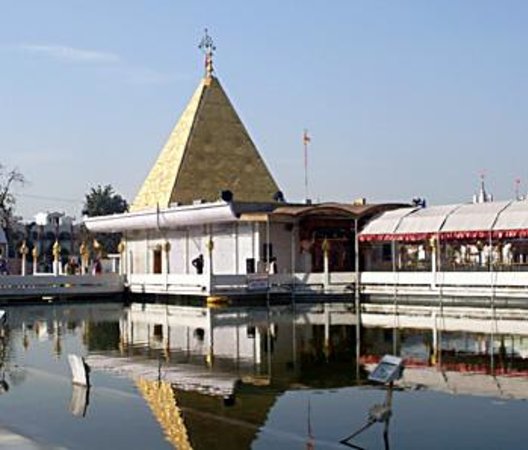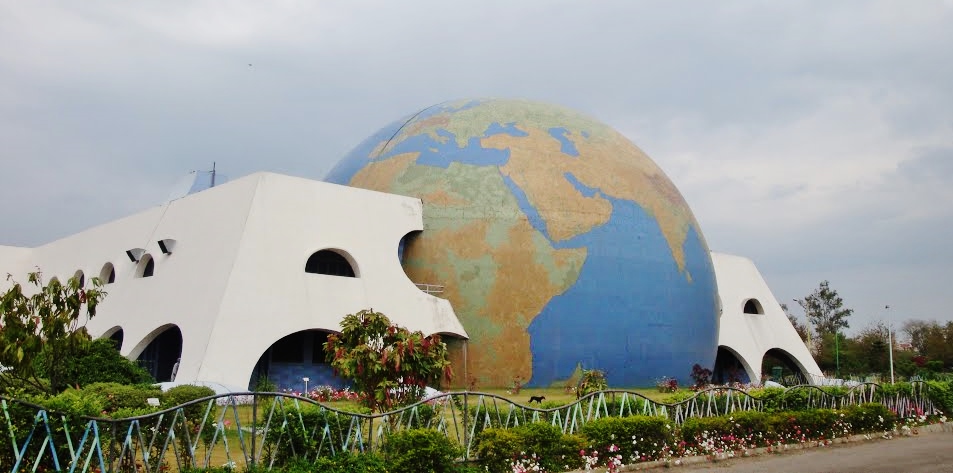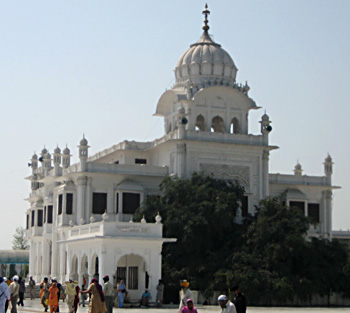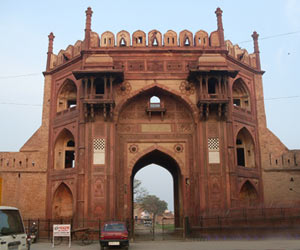Day 35
Jalandhar is a city that is located in the Jalandhar district of the state of Punjab.Jalandhar is another name of Lord Shiva.It is believed to have emerged out of the sea. This legendary origin of Jalandhar is confirmed by some geologists who believe that once upon a time the sea stretched up to Jalandhar Doab and the neighbouring Shiwaliks of Hoshiarpur. According to the Padma Purana, the City takes its name from the great "Daitya" King , Jalandhra, the son of the Ocean.Jalandhar gave rise to the Nath Movement between the eighth and tenth century A.D. At the site where the samadh of one of the foremost representatives of the movements Jogi Jalandhar Nath once stood, was built the exiting shrine of Imam Nasir-ud-din Chishti in the fifteenth century.The city proper of Jalandhar was, when visited by Hiuen Tsiangg, a large city, miles in circuit, and functioned as the capital of a Rajput kingdom.[2] Raja Utito was a tributary of Harsh Vardhana. The Rajput Rajas appear to have continued to rule over the country right up to the 12th century, with occasional interruptions, but their capital was Jalandhar and Kangra formed an important stronghold.Jalandhar boasts of many historic monuments.
How to reach here:
By Air: Raja Sansi International Airport, Amritsar (ATQ) is the nearest airport.
By Rail: Jalandhar has a railway station that is well connected to places such as Delhi, Amritsar, Jammu and others.
Best time to visit: October to March.
Languages spoken: Punjabi, Hindi and English.
Must eat: Aloo Ka paratha, Lassi.
Famous Restaurants: Havelli, Rangla, Manni.
Places you must see:
Devi Talab Mandir is situated in the heart of Jalandhar City. The old Devi Talab has been renovated and, in its centre, a new temple has been built. Recently a model of Amarnath Yatra has been built in the premises. An old temple of goddess Kali also stands by the side of the Devi Talab.

Tulsi Mandir an ancient monument in the City is the temple of Vrinda, wife of Jalandhara, in the Kot Kishan Chand locality. It is now also known as Tulsi Mandir. On one side of the temple is a tank which is said to have been the bathing place of the demon Jalandhara.At some distance is the temple of Gupha, with the image of Annapurna, the goddess of plenty, installed in it. Also nearby lies the Brahm Kund and some temples dedicated to Shiva.Near the Balmiki gate is the Sheetla Mandir, said to be as old as the City of Jalandhar. Within its premises are also two small old temples of Hanuman and Shiva.

Shiva Mandir was built by the Nawab of Sultanpur Lodhi, is situated in Gur Mandi near Masjid Imam Nasar. It is said that the Nawab eyed a newly married Hindu girl whom he wanted to make an object of his lust. The girl, a devotee of Lord Shiva, was saved by a serpent.Surprised by the appearance of this serpent, the Nawab begged pardon from the girl and later built this temple, which has an unusual architectural design. The gate of the mandir is built in the style of a mosque and the rest of the mandir is built in the Hindu style.

Sodal Mandir is situated the near Devi Talab Mandir on Sodal Road. Baba Sodal was born in a family of the Chadha clan of the Khatri caste in Jalandhar city. It is said that one day, Baba Sodal’s mother went to the nearby pond to wash clothes and Baba Sodal followed her despite being told repeatedly not to do so and go back home.Losing her temper, Baba Sodal's mother asked him to drown himself in the pond. Sodal asked her to repeat her words three times and as she did, he plunged into the water never to appear again. Some believe that he died on the spot, whereas some trust that he transformed into a snake and bored himself inside the earth.The Samadhi consisting of a painted portrait of Baba Sodal decorated with garland and rosaries is the main place of worship. There is a tank called Baba Sodal-da-Sarovar where pilgrims take a holy dip.

Pushpa Gujral Science City is being built with its aim of learning, fun & amusement out of Science for people of all ages & all walks of life. It will arouse creativity in young minds, help in building a scientific temper in the state.The subject areas covered here include physical, applied, natural and social sciences, engineering, technology, agriculture, health sciences, energy, industries as well as human evolution and civilization. Environment, ecosystems, Jurassic park, space, nuclear science, information technology, robotics and bio-technology are other subjects covered at the Science City.


St Mary’s Cathedral Church is dedicated to St. Patrick was built by Rev. Fr. John Macodnnel, Q.F.M.CAP of the Vicariate Apostolic of Agra, in 1947 at the same site of new church since 1886.The old church was demolished on 15th February, 1987 and the foundation stone for the new church was blessed by Pope John Paul II in February 1986. It was laid by His Excellency Rt. Rev. Dr. Symbhorian Keeprath Bishop of Jalandhar Diocese on 19th April 1987. The church was designed to highlight the secular character of India.

Gurudwara Chhevin Padshahi : Guru Hargobind, the sixth Guru of Sikhs, visited the city of Jalandhar during his tour of Doaba area. It is here at the spot, where Guru Hargobind Singh was interviewed by a holy Musilm saint, Sheikh Darvesh, that the Gurdwara Chhevin Padshahi stands. The saint blindfolded his eyes so that he could swear before the Mogul authorities that he had not seen the Guru. The great Guru had an in depth discussion with the saint about spiritual matters.

Shaheed-E-Azam Sardar Bhagat Singh Museum was built to pay homage to the great revolutionary martyrs of the Punjab, who laid down their lives for the liberation of their motherland, all their memorable belongings are displayed here. The half burnt ashes of Sardar Bhagat Singh, Rajguru and Sukhdev including the blood soaked sand and blood stained newspaper in which their ashes were wrapped are preserved and exhibited in the museum. One page of the Lahore Conspirace Case’s Judgement through which martyr Kartar Singh Sarabha was sentenced to death and on which Sardar Bhagat Singh put some notes is also exhibited in the museum. A copy of holy Gita having S. Bhagat Singh’s signatures which was handed over to him in Lahore Jail, and his other personal belongings are displayed here. The painting of the revolutionaries and Gadrites who inspired S. Bhagat Singh to jump into the freedom struggle are also displayed in the museum. A big bronze statue in the memory of the great martyr installed in front of the museum remind us of his great deeds.

Moorish Mosque is situated in Kapurthala about 21 km from Jalandhar. The mosque was built in 1930 by a French architect Manteaux, during the reign of Jagatjit Singh, the last Maharaja of Kapurthala. The design resembles that of the great Qutbiya Mosque, at Marakesh in Morocco. The inner dome of the mosque have designs by the artists of the Mayo School of Arts, Lahore.

Panch Mandir is an architecturally beautiful temple located 21 km from Jalandhar in Kapurthala town. The mandir, the most striking monument in the town was built by Fateh Singh Ahluwaliah, the founder of the Kapurthala State. The main dome in the center is surrounded by several smaller temples dedicated to different deities.

Gurudwara Ber Sahib is situated in Sultanpur Lodhi in Kapurthala district, 36km from Jalandhar. This is the place where the first prophet Guru Nanak got enlightenment and created 'Sukhmani Sahib' while taking bath in the river Kali Bein. It was from Sultanpur Lodhi that Guru Nanak embarked on his long preaching odysseys called 'Udasis' in the Sikh tradition.


Serai Nurmahal Nurmahal, a small town around 40 km from Jalandhar is associated with Nurjahan, wife of Emperor Jahangir, known for her beauty and style of living. Mughal Serai alias Serai Nurmahal, said to be constructed for Nurjahan, is a remarkable specimen of oriental architecture. Its massive gate embellished with arches, filigree work and tiles of beautiful patterns, topped by 4 delicate minarets make it a place worth a visit.

Gurudwara at Kartarpur was built by the Fifth Sikh Guru, Guru Arjun Devji in 1656 A.D. Every year, a fair is held on the birth anniversary of the Guru when a large number of devotees gather to pay homage. Kartarpur is also known as the birth place of Swami Virjanand who was the teacher of Swami Dayanand Saraswati, the illustrious founder of the Arya Samaj.

Jalandhar is a city that is located in the Jalandhar district of the state of Punjab.Jalandhar is another name of Lord Shiva.It is believed to have emerged out of the sea. This legendary origin of Jalandhar is confirmed by some geologists who believe that once upon a time the sea stretched up to Jalandhar Doab and the neighbouring Shiwaliks of Hoshiarpur. According to the Padma Purana, the City takes its name from the great "Daitya" King , Jalandhra, the son of the Ocean.Jalandhar gave rise to the Nath Movement between the eighth and tenth century A.D. At the site where the samadh of one of the foremost representatives of the movements Jogi Jalandhar Nath once stood, was built the exiting shrine of Imam Nasir-ud-din Chishti in the fifteenth century.The city proper of Jalandhar was, when visited by Hiuen Tsiangg, a large city, miles in circuit, and functioned as the capital of a Rajput kingdom.[2] Raja Utito was a tributary of Harsh Vardhana. The Rajput Rajas appear to have continued to rule over the country right up to the 12th century, with occasional interruptions, but their capital was Jalandhar and Kangra formed an important stronghold.Jalandhar boasts of many historic monuments.
How to reach here:
By Air: Raja Sansi International Airport, Amritsar (ATQ) is the nearest airport.
By Rail: Jalandhar has a railway station that is well connected to places such as Delhi, Amritsar, Jammu and others.
Best time to visit: October to March.
Languages spoken: Punjabi, Hindi and English.
Must eat: Aloo Ka paratha, Lassi.
Famous Restaurants: Havelli, Rangla, Manni.
Places you must see:
Devi Talab Mandir is situated in the heart of Jalandhar City. The old Devi Talab has been renovated and, in its centre, a new temple has been built. Recently a model of Amarnath Yatra has been built in the premises. An old temple of goddess Kali also stands by the side of the Devi Talab.

Tulsi Mandir an ancient monument in the City is the temple of Vrinda, wife of Jalandhara, in the Kot Kishan Chand locality. It is now also known as Tulsi Mandir. On one side of the temple is a tank which is said to have been the bathing place of the demon Jalandhara.At some distance is the temple of Gupha, with the image of Annapurna, the goddess of plenty, installed in it. Also nearby lies the Brahm Kund and some temples dedicated to Shiva.Near the Balmiki gate is the Sheetla Mandir, said to be as old as the City of Jalandhar. Within its premises are also two small old temples of Hanuman and Shiva.

Shiva Mandir was built by the Nawab of Sultanpur Lodhi, is situated in Gur Mandi near Masjid Imam Nasar. It is said that the Nawab eyed a newly married Hindu girl whom he wanted to make an object of his lust. The girl, a devotee of Lord Shiva, was saved by a serpent.Surprised by the appearance of this serpent, the Nawab begged pardon from the girl and later built this temple, which has an unusual architectural design. The gate of the mandir is built in the style of a mosque and the rest of the mandir is built in the Hindu style.

Sodal Mandir is situated the near Devi Talab Mandir on Sodal Road. Baba Sodal was born in a family of the Chadha clan of the Khatri caste in Jalandhar city. It is said that one day, Baba Sodal’s mother went to the nearby pond to wash clothes and Baba Sodal followed her despite being told repeatedly not to do so and go back home.Losing her temper, Baba Sodal's mother asked him to drown himself in the pond. Sodal asked her to repeat her words three times and as she did, he plunged into the water never to appear again. Some believe that he died on the spot, whereas some trust that he transformed into a snake and bored himself inside the earth.The Samadhi consisting of a painted portrait of Baba Sodal decorated with garland and rosaries is the main place of worship. There is a tank called Baba Sodal-da-Sarovar where pilgrims take a holy dip.

Pushpa Gujral Science City is being built with its aim of learning, fun & amusement out of Science for people of all ages & all walks of life. It will arouse creativity in young minds, help in building a scientific temper in the state.The subject areas covered here include physical, applied, natural and social sciences, engineering, technology, agriculture, health sciences, energy, industries as well as human evolution and civilization. Environment, ecosystems, Jurassic park, space, nuclear science, information technology, robotics and bio-technology are other subjects covered at the Science City.


St Mary’s Cathedral Church is dedicated to St. Patrick was built by Rev. Fr. John Macodnnel, Q.F.M.CAP of the Vicariate Apostolic of Agra, in 1947 at the same site of new church since 1886.The old church was demolished on 15th February, 1987 and the foundation stone for the new church was blessed by Pope John Paul II in February 1986. It was laid by His Excellency Rt. Rev. Dr. Symbhorian Keeprath Bishop of Jalandhar Diocese on 19th April 1987. The church was designed to highlight the secular character of India.

Gurudwara Chhevin Padshahi : Guru Hargobind, the sixth Guru of Sikhs, visited the city of Jalandhar during his tour of Doaba area. It is here at the spot, where Guru Hargobind Singh was interviewed by a holy Musilm saint, Sheikh Darvesh, that the Gurdwara Chhevin Padshahi stands. The saint blindfolded his eyes so that he could swear before the Mogul authorities that he had not seen the Guru. The great Guru had an in depth discussion with the saint about spiritual matters.

Shaheed-E-Azam Sardar Bhagat Singh Museum was built to pay homage to the great revolutionary martyrs of the Punjab, who laid down their lives for the liberation of their motherland, all their memorable belongings are displayed here. The half burnt ashes of Sardar Bhagat Singh, Rajguru and Sukhdev including the blood soaked sand and blood stained newspaper in which their ashes were wrapped are preserved and exhibited in the museum. One page of the Lahore Conspirace Case’s Judgement through which martyr Kartar Singh Sarabha was sentenced to death and on which Sardar Bhagat Singh put some notes is also exhibited in the museum. A copy of holy Gita having S. Bhagat Singh’s signatures which was handed over to him in Lahore Jail, and his other personal belongings are displayed here. The painting of the revolutionaries and Gadrites who inspired S. Bhagat Singh to jump into the freedom struggle are also displayed in the museum. A big bronze statue in the memory of the great martyr installed in front of the museum remind us of his great deeds.

Moorish Mosque is situated in Kapurthala about 21 km from Jalandhar. The mosque was built in 1930 by a French architect Manteaux, during the reign of Jagatjit Singh, the last Maharaja of Kapurthala. The design resembles that of the great Qutbiya Mosque, at Marakesh in Morocco. The inner dome of the mosque have designs by the artists of the Mayo School of Arts, Lahore.

Panch Mandir is an architecturally beautiful temple located 21 km from Jalandhar in Kapurthala town. The mandir, the most striking monument in the town was built by Fateh Singh Ahluwaliah, the founder of the Kapurthala State. The main dome in the center is surrounded by several smaller temples dedicated to different deities.

Gurudwara Ber Sahib is situated in Sultanpur Lodhi in Kapurthala district, 36km from Jalandhar. This is the place where the first prophet Guru Nanak got enlightenment and created 'Sukhmani Sahib' while taking bath in the river Kali Bein. It was from Sultanpur Lodhi that Guru Nanak embarked on his long preaching odysseys called 'Udasis' in the Sikh tradition.

Masoleums of Ustad and Shagird are two beautiful 17th century tombs are situated in Nakodar. One of them belongs to Ustad (teacher) Mohammed Momin Hussaini alias Hafizah, a musician in the service of 'Khan-e-Khana'- the chamberlain of Emperor Jahangir. The other tomb belongs to Haji Jamal, his disciple. The mausoleums are similar in architecture to Emperor Humayun's tomb in Delhi and stand out as buildings of great attraction.

Serai Nurmahal Nurmahal, a small town around 40 km from Jalandhar is associated with Nurjahan, wife of Emperor Jahangir, known for her beauty and style of living. Mughal Serai alias Serai Nurmahal, said to be constructed for Nurjahan, is a remarkable specimen of oriental architecture. Its massive gate embellished with arches, filigree work and tiles of beautiful patterns, topped by 4 delicate minarets make it a place worth a visit.

Gurudwara at Kartarpur was built by the Fifth Sikh Guru, Guru Arjun Devji in 1656 A.D. Every year, a fair is held on the birth anniversary of the Guru when a large number of devotees gather to pay homage. Kartarpur is also known as the birth place of Swami Virjanand who was the teacher of Swami Dayanand Saraswati, the illustrious founder of the Arya Samaj.

Nice images and post also. Thanks for sharing with us. Hotels in Jalandhar are also very good. From cosy accommodations to the palatable food, from modern day comforts to convenience of access, you can enjoy it all being in Jalandhar. Check all good hotels in Jalandhar.
ReplyDeleteGreat Information, I will visit Jalandhar city as soon as possible. Thanks for sharing awesome information.
ReplyDeletepay for essay